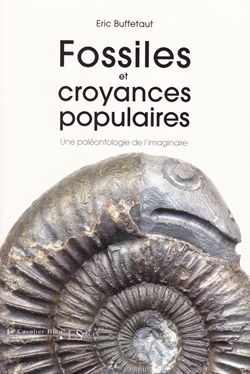
The pleasing double meaning hinted at in the subtitle of Eric Buffetaut’s wonderful and amusing new popular book (
‘A palaeontology of the imaginary’) should alone be enough to encourage you to brush up your French and buy a copy. Palaeontologists are only the latest group of people to have thought about fossils, and in conducting this well-ordered and systematic survey of the influence of fossils on the pre-scientific mind, the author is also conducting a form of palaeontology of the human imagination. These ‘fossilized’ beliefs merit more than the condescension normally accorded them in the introductions to student textbooks - to be contrasted, usually, with the more enlightened ideas of the great savants (with what my old Prof Derek Ager used to call ‘the inevitable references to Leonardo da Vinci’).
Buffetaut wishes us to understand that people of all periods in history interpreted the world through the lens of their prevailing belief systems, and illustrates this point in case after case, drawn from ancient and primitive cultures all over the world. The result is a fascinating mixture of myth and folk tale, history, anthropology. But if you ask -
what came first, the myth or the fossil? Buffetaut will answer that it is nearly always the myth. The fossils are later pressed into service.
Beginning with archaeological evidence that our Palaeolithic ancestors collected fossils too, even using them as jewellery and burial offerings, we are taken on a journey involving ammonites as serpents petrified by divine agency, shark’s teeth as serpents’ tongues, coprolites as unlikely talismans, belemnites as fairy weapons, and much, much more.
There was often money to be made in this. ‘Unicorn’s horn’ (often a narwhal tusk, but also occasionally mammoth tusk also) could command enormous sums, greater than gold, for its supposed curative powers. Dragons, likewise, were often invoked in people’s attempts to explain puzzling fossil finds such as bear skulls; and the powers attributed to the supposed remains varied according to whether the dragon was maleficent (as in the Western tradition) or beneficent (as for the Chinese). Mammal remains from the Tertiary, being often large, close to surface and in sub-fossil condition, became evidence for the veracity of folk tales featuring giants, or antediluvian heroes; or even in some cases became mixed up with well-known accounts from history, such as Hannibal’s elephantine traverse of the Alps. It is all fascinating.
I regret very much the book's lack of index, which would have been so valuable with so many stories and characters and objects to remember. The in-text black and white engravings are also a bit minimal. But the main question I was left asking was: why would such an excellent popular book as this stand so little chance of publication in English in this form? The author is not trying to sell any far-fetched hypothesis, for one thing. Its approach is perhaps a little more like that of continental-style science generally. Refreshingly free of the overbearing hypothesis-testing mania that has overtaken others, Buffetaut just tells us what’s out there. He has collected a wealth of interesting and amusing historical detail, arranged it in varied and well-ordered chapters for a publisher who has not succumbed to the temptation to make the book impossibly expensive (and heavy) by having full colour throughout, hard covers and lavish photographic illustrations. I find much to applaud in that.
But don’t hold your breath for a translation – read it in the original.
Reviewed by Ted Nield
FOSSILES ET CROYANCES POPULAIRES – UNE PALÉONTOLGIE DE L’IMAGINAIRE, by ERIC BUFFETAUT 2017 Editions Le Cavalier Bleu, 164pp, sbk W:
www.lecavalierbleu.com. List price: €18.00